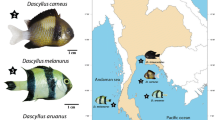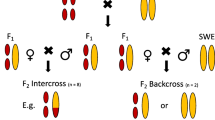Summary
By means of the male sample method samples of D. subobscura from the north and south coast of Asia Minor and from the south coast of the Caspian Sea were examined with regard to the gene arrangements contained in them. The samples were judged by the following three criteria: (1) the number of different gene arrangements present, (2) the frequencies in which these gene arrangements occur, and (3) the rate of zygotic combinations.
The samples from Asia Minor were found to be highly polymorphic. In this respect, they are comparable with other samples from the northern border of the Mediterranean region.
The Persian populations are poor as regards number of gene arrangements. Commonly, some gene arrangements are highly frequent and, accordingly, high rates of homozygous combinations dominate. Presumably, these are marginal populations.
Comparisons between samples from the north and south coast of Asia Minor confirm the findings from other parts of the species' range. As a rule, the frequencies of various gene arrangements vary according to the latitude in which they occur. Since climate and vegetation are also largely correlated with latitude, it is assumed that this is due to adaptive reaction to ecological factors.
Comparing populations from the Western and Eastern Mediterranean region, similar differences were recorded. Some gene arrangements seem to be confined to either the western or eastern part of the area, and other gene arrangements differ in frequency. Since the ecological conditions in these areas appear to be comparable, such differences might be due to the history of the formation and dispersal of gene arrangements.
In general, the frequencies of the gene arrangements in the chromosomes A, U, E and O are most equal along the northern margin of the Mediterranean area and, correspondingly, the frequencies of the heterokaryotypes are highest. It may be assumed that many heterokaryotypes reach their highest degree of heterotic supremacy in this area, and/or that the different homokaryotypes are uniform with respect to adaptive values. The reasoning rests on the additional assumption that in this area the biological conditions are the least extreme, or, in other words, that D. subobscura is best adapted to this environment. As it is, the region appears to lie geographically near the center of the species' range. In the I-chromosome the most equal frequencies of gene arrangements along with the highest frequency of the heterokaryotypes are to be found in Central Europe.
On the other hand, in various populations lying supposedly at the borders of the species' range, the frequencies of gene arrangements of at least some chromosomes are strongly unequal and, accordingly, the frequencies of the homokaryotypes are high.
In populations where the polymorphism is high, the character of the polymorphism varies slightly from chromosome to chromosome. In the O-chromosome usually one gene arrangement is abundant, while a large number of others are rare; two gene arrangements tend to dominate in the I- and U-chromosome, whereas in the E-chromosome several gene arrangements are apt to share similar frequencies.
Similar content being viewed by others
Literatur
Burla, H., u. W. Götz: Veränderlichkeit des chromosomalen Polymorphismus bei Drosophila subobscura. Genetica 36, 83–104 (1965).
Carson, H. L.: Variation in genetic recombination in natural populations. J. comp. cell. Physiol. 45, Suppl. 2, 221–236 (1955a).
—: The genetic characteristics of marginal populations of Drosophila. Cold Spr. Harb. Symp. quant. Biol. 20, 276–287 (1955b).
da Cunha, A. B., H. Burla, and Th. Dobzhansky: Adaptive chromosomal polymorphism in Drosophila willistoni. Evolution (Lancaster, Pa.) 4, 212–235 (1950).
—, Th. Dobzhansky, O. Pavlovsky, and B. Spassky: Genetics of natural populations. XXVIII. Supplementary data on the chromosomal polymorphism in Drosophila willistoni in its relation to the environment. Evolution (Lancaster, Pa.), 13, 389–404 (1959).
Dobzhansky, Th., and O. Pavlovsky: Interracial hybridization and breakdown of coadapted gene complexes in Drosophila paulistorum and Drosophila willistoni. Proc. nat. Acad. Sci. 44, 622–629 (1958).
Götz, W.: Beitrag zur Kenntnis der Inversionen, Duplikationen und Strukturtypen von Drosophilo subobscura Coll. Z. Vererbungsl. 96, 285–296 (1965).
—: Chromosomaler Polymorphismus in einem Muster von Drosophila subobscura aus Marokko, mit Darstellung der Heterozygotieverhältnisse als Heterozygotiediagramm. Z. Vererbungsl. 97, 40–45 (1965).
Goldschmidt, E.: Chromosomal polymorphism in a population of Drosophila subobscura from Israel. J. Genet. 54, 474–496 (1956).
—: Polymorphism and coadaptation in natural populations of Drosophila subobscura. Proc. Tenth. int. Congr. Ent. (Montreal) 2, 821–828 (1958).
Greuter, M. W.: Vergleich der Ausbreitungsaktivitäten von Drosophila subobscura und Drosophila obscura. Rev. suisse Zool. 70, 759–856 (1963).
Knight, G. R.: Structural polymorphism in Drosophila subobscura from various localities in Scotland. Genet. Res. 2, 1–9 (1961).
Krimbas, C. B.: The genetics of Drosophila subobscura populations. I. Inversion polymorphism in populations of Southern Greece. Evolution (Lawrence, Kansas) 18, 541–552 (1964a).
—: The genetics of Drosophila subobscura populations. II. Inversion polymorphism in a population from Holland. Z. Vererbungsl. 95, 125–128 (1964b).
Kunze-Mühl, E., u. E. Müller: Weltere Untersuchungen über die chromosomale Struktur und die natürlichen Strukturtypen von Drosophila subobscura. Chromosoma (Berl.) 9, 559–570 (1958).
—— u. D. Sperlich: Qualitative, quantitative und jahreszeitliche Untersuchungen über den chromosomalen Polymorphismus natürlicher Populationen von Drosophila subobscura in der Umgebung von Wien. Z. Vererbungsl. 89, 636–646 (1958).
—, u. D. Sperlich: Vergleichende Untersuchungen über den chromosomalen Strukturpolymorphismus in Insel- und Festlandspopulationen von Drosophila subobscura. Z. Vererbungsl. 93, 237–248 (1962).
Owen, D. B.: Handbook of statistical tables. London: Addison-Wesley Publ. Co. 1962.
Pentzos-Daponte, A.: Qualitative und quantitative Untersuchungen über den chromosomalen Polymorphismus natürlicher Populationen von Drosophila subobscura in der Umgebung von Thessaloniki/Griechenland. Z. Vererbungsl. 95, 129–144 (1964).
Prevosti, A.: Chromosomal polymorphism in Drosophila subobscura populations from Barcelona (Spain). Genet. Res. 5, 27–38 (1964).
Schmid, E.: Prinzipien der natürlichen Gliederung der Vegetation des Mediterrangebietes. Ber. schweiz. bot. Ges. 59, 169–200 (1949).
Sperlich, D.: Modellversuche zur Selektionswirkung verschiedener chromosomaler Strukturtypen von Drosophila subobscura Coll. Z. Verebungsl. 89, 422–436 (1958).
—: Untersuchungen über den chromosomalen Polymorphismus einer Population von Drosophila subobscura auf den Liparischen Inseln. Z. Vererbungsl. 92, 74–84 (1961).
—: Chromosomale Strukturanalyse und Fertilitätsprüfung an einer Marginalpopulation von Drosophila subobscura. Z. Vererbungsl. 95, 73–81 (1964).
—, u. E. Kunze-Mühl: Der chromosomale Polymorphismus einer Population von Drosophila subobscura auf der Insel Ustica im Vergleich mit anderen Insel- und Festlandstandorten. Z. Vererbungsl. 94, 94–100 (1963).
Stumm-Zollinger, E.: Vergleichende Untersuchungen über die Inversionshäufigkeit bei Drosophila subobscura in Populationen der Schweiz und Südwesteuropas. Z. indukt. Abstamm.- u. Vererb.-Lehre 85, 382–407 (1953).
—, and E. Goldschmidt: Geographical differentiation of inversion system in Drosophila subobscura. Evolution (Lancaster, Pa.) 13, 89–98 (1959).
Walter, H., u. H. Lieth: Klimadiagramm-Weltatlas. Jena: VEB Gustav Fischer 1960.
Author information
Authors and Affiliations
Rights and permissions
About this article
Cite this article
Götz, W. Untersuchungen über den chromosomalen Strukturpolymorphismus in kleinasiatischen und persischen Populationen von Drosophila subobscura Coll.. Molec. Gen. Genet. 100, 1–38 (1967). https://doi.org/10.1007/BF00425773
Received:
Issue Date:
DOI: https://doi.org/10.1007/BF00425773




